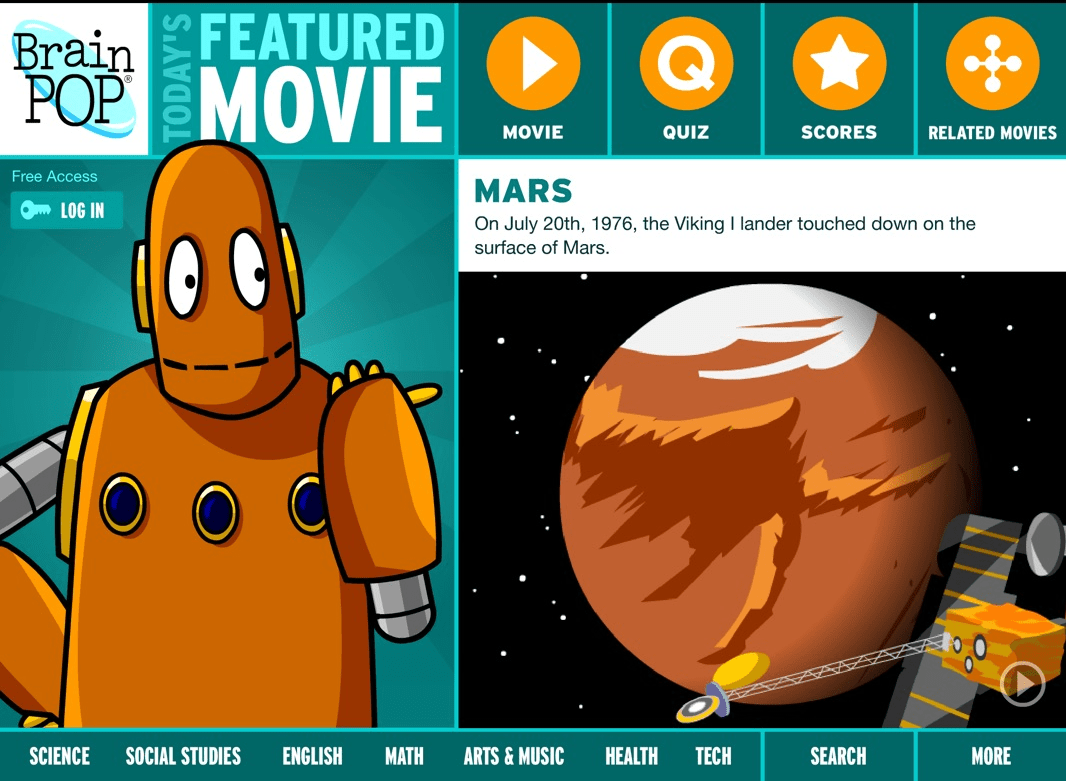Up until a few years ago, the mention of BrainPOP or BrainPOP Jr. conjured a much different vision in my mind than it does now. My first encounters came from searches for quality educational videos.

BrainPOP’s short movies famously feature a robot named Moby as he and his friends explore the world. Each animated video tackles topics which range from how a food chain works to economic recession to Abraham Lincoln and much more. Science, social studies, math, the arts, engineering, and math, are a few of the categories offered on the site.
The videos are highly engaging and packed with humor, positive messages, and satisfying information. Currently there are over 1000 videos available. And the videos aren’t just for elementary students. Many are pertinent to students all the way up to 12th grade.

For many years I loved using these videos in my classroom but I was blocked from their best videos because the site requires a purchased membership. I could tell there was good content available but I was undecided if the fee was worthwhile.
Then a miracle, of sorts, happened. In 2018, I took my annual pilgrimage to the Alaska Society for Technology in Education (ASTE) conference, one of the biggest gatherings of educators in the state, and was excited to learn that Alaska’s State Library and the Alaska Department of Education and Early Development (DEED) fund a BrainPOP licence that opens up all of the amazing features to every citizen in our state.

My first thought was, “Great news…. Now I can show all of those incredible videos to my students.” but I wanted to learn more about the other features so I went to a training session offered by Brainpop Lead Learner, Robert Miller, who came to ASTE to promote BrainPOP.

Within a few hours I realized that BrainPOP videos barely scrape the surface of the program. The training made me so excited for this platform, I went home and completed the BrainPOP training to be a certified educator. BrainPOP has become a staple in my classroom because it quickly takes students into deeper learning.
Here is a sampling of the features I’ve used with my students:
- Make-a-Map: While viewing a video, students use this tool to take notes and create a digital graphic organizer based on the information they have learned. The coolest feature within Make-a-Map is the ability to insert a photo or short clip from the video into the mind-map.
- Make-a-Movie: This is my favorite feature because it allows students to create their own movies that demonstrate their own knowledge of a topic. It is easy and intuitive to use. My own young sons are always creating movies at home. Last year one of them won a category of the ASTE Ididacontest with his BrainPOP movie about giant squid.
- Creative Coding: This is a fairly new feature but it is a promising way to teach coding to students. Students use characters from the Brainpop universe to learn how to code. They can use code to tell a story, have a conversation, design a game, make a meme, produce a newscast, or code in other creative ways.
- Games: At first I was learly of the games. Afterall, we’ve all had experiences with students who get hooked on playing cheesy, useless “educational” games and miss the deeper learning opportunities. However, you can be assured that students will be in a deeper learning zone while playing these award winning games. The games are associated with every movie, for all grade levels. I highly recommend any of the Sortify games.

There is no way that I can, in such few words, express all of the amazing features of BrainPOP. I highly encourage anyone in education who is interested in BrainPOP to go to educators.brainpop.com and involve yourself in one of the many professional development opportunities they offer. BrainPOP 101 or signing up for a webinar is a great place to start.
I applaud the Alaska State Library and DEED for the wonderful gift of BrainPOP. It is well designed for modern learning, be it distance or in the classroom. I hope many Alaskan teachers and students will take advantage of BrainPOP and the depth of its features.
If you have questions about Alaska’s BrainPOP education, please contact Martha Ketsdever, BrainPOP Account Manager for Alaska State Libraries.